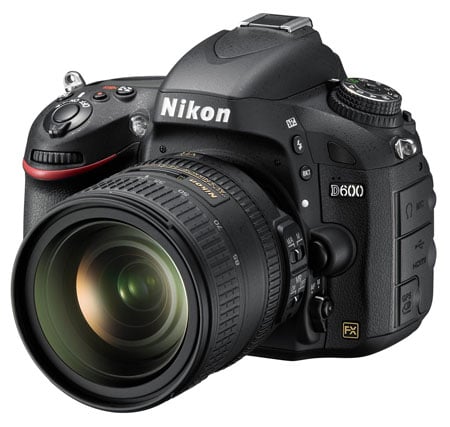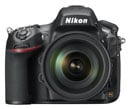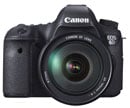Nikon D600 review
-
-
Written by Gordon Laing
Verdict
The D600 is Nikon’s first ‘affordable’ full frame DSLR. This puts it in a pivotal position in the Nikon line-up. In one sense it’s a pared back verson of the D800, in another it’s an upscaled version of the D7000. One thing’s for certain: it’s going to be a very attractive proposition for both existing D800 and D4 owners looking for a back-up body as well as for aspiring amateurs for whom full frame digital photography is now just about within reach.
The D600’s 24.2 Megapixel sensor falls well short of the D800’s monster 36 Megapixel resolution but, with Canon’s EOS 5D Mark III at 22.3 Megapixels and the more affordable EOS 6D at 20.2 Megapixels there isn’t another full frame DSLR that can beat it on resolution. The Sony Alpha SLT-A99 may share the same 24 Megapixel resolution, but is significantly more expensive.
The D600 offers a DX crop mode which means upgraders can still use their DX lenses, (note owners of Canon EF-S mount lenses can’t use them on the 6D) albeit with reduced resolution 10.5 Megapixel images. There’s also a built-in AF motor that makes it possible to use older non-AF-S lenses while retaining autofocus capability.
Manufacturers are understandably careful not to cannibalize their own product line by offering models at different price points that are closely matched, but it’s to Nikon’s credit that a lot of the D800’s features and functions are present in the D600. Yes, the AF system is closer to that of the D7000 with 39 points including nine cross-type sensors, the front panel is plastic, the USB is 2.0 not 3.0, the maximum flash sync and shutter speeds are 1/200 and 1/4000, and there’s no PC sync socket, but these are all things it’s easy for most people to get by without. Particularly when you consider that both cameras share essentially the same video specification with a 1080p30 best quality mode and that the headline features – viewfinder, LCD screen, weather sealing, and dual card slots are equivalent and in the case of continuous shooting better. So before wrapping-up, here’s another comparison with its closest rivals.
 |
Compared to Nikon D800
The D800 is the next step up the food chain from the D600: it’s a bigger, heavier, semi-pro full-frame body with a price tag that’s around 50 percent higher. So what does that extra cash buy you? The D800’s construction is all Magnesium alloy, whereas the D600 has Magnesium alloy top and rear panels with a plastic front. So the D800 is tougher, but both models share the same level of weatherproofing.
Then, of course, there’s the sensor. With its 36 Megapixel sensor the D800 produces images with resolutions approaching those produced by medium format digital backs. If you want to make massive prints, or simply crave the level of detail only that kind of high resolution sensor can provide, the choice is clear, but the 24.3 Megapixel D600 is itself no slouch in the resolution stakes. One thing that’s worth considering though, is that the D800’s high resolution means that in DX crop mode you still get 16 Megapixel images, whereas on the D600 you’re reduced to a mere 10.5 Megapixels.
What else is different? To be honest not as much as you might expect. The D800 has a 51 point AF system compared with 39 on the D600. Its fastest shutter speed is 1/8000 compared with 1/4000 on the D600, it has a USB 3.0 port, compared with USB 2.0 on the D600, it sports silent aperture controls for video (but only when using an external recorder), and it also has a PC sync socket for use with studio flash. The D600 also has a slower flash sync speed – 1/200 compared with 1/250 on the D800. In it’s favour, the D600 boasts faster continuous shooting at 5.5fps compared with 4fps on the D800, but its exposure bracketing is limited to 3 frames compared with 9 on the D800. Finally, both cameras offer dual card slots, but both are SD slots on the D600 compared with CF and SD on the D800.
But these two models are defined more by what they have in common than their differences. They share essentially the same video modes with built-in stero microphones as well as sockets for connecting an external mic and headphones. The D600 lacks the D800’s ability to change aperture while recording, but otherwise there’s nothing to choose between them as video cameras. In most other respects it’s like for like; the viewfinder, LCD screen, ISO range are identical, shooting modes, the dual-axis level, interval timer, and most other features are the same too. Essentially, the D800 is a bigger, tougher, heavier, more capable D600 with a higher resolution sensor, better AF and one or two other refinements. To answer my original question, mostly what your paying for is the extra resolution and the option to buy a version without the anti-aliasing filter. Some will justify paying the extra, while others will find the D600 hits the sweetspot.
See my Nikon D800 review for more details.
Compared to Canon EOS 6D
The battle between the Nikon D600 and the Canon EOS 6D is an important one for both companies because it’s an opportunity for each to poach customers from the other – or to lose them. If you ignore the presence of mirrorless compact system cameras, the logical upgrade path for owners of APS-C bodies is to go for an affordable full frame model. But if, like many consumer DSLR owners, you haven’t invested in additional lenses it’s an easy matter to switch allegiances. So with the D600 Nikon is looking not only to keep its existing customers in the fold, but to attract Canon ones into it too. Canon is doing the exact same with the 6D and both are fighting hard because the newly created affordable DSLR market they’ve created between them is very open.
So how do they stack up? The obvious place to start is the sensor. Nikon’s 24.3 Megapixel sensor has a slightly higher resolution than the 20.2 Megapixel sensor in the 6D, but the quality from these two sensors is pretty evenly matched, although it’s worth noting Canon takes a more agressive stance on noise reduction for JPEGs. Perhaps more importantly, the D600 offers a DX format crop mode which allows you to continue using any DX lenses you may own at a reduced 10.5 Megapixel resolution. That’s likely to be a significant factor for existing Nikon owners looking to upgrade. Canon EOS 6D users upgrading from an APS-C body aren’t so fortunate as EF-S lenses aren’t compatible with any full frame Canon body, including the 6D.
Next to resolution, the factor that will likely influence many buyers is the respective AF systems, but I reckon this is something of a red herring. On the face of it, the Nikon D600’s 39-point AF system with 9 cross-type sensors is more sophisticated and capable than the 6D’s 11-point AF system which has only one central cross-type sensor. The D600’s additional sensors may cover a larger area, be more configurable and better at tracking small moving subjects, but that’s only half the story. The Canon EOS 6D’s AF system is sensitive at much lower light levels, meaning you can continue to use AF until it’s almost dark. So for shooting in very low light, for example in the late evening and at night, the 6D wins out.
A larger brighter viewfinder is one of the advantages a full-frame DSLR offers and although the EOS 6D’s viewfinder doesn’t offer full 100 percent coverage like the D600 the difference is negligible and a side-by-side comparison doesn’t reveal any significant differences between them. What is different is that the D600 allows you to turn off the AF point overlay and add a grid if you want it, whereas on the 6D you’ll have to physically swap the glass focussing screen. At 3.2 inches diagonally, the D600’s LCD screen is slightly larger than the 3 inch screen of the 6D and shares similar resolution, but the different aspect ratios mean the image on the 6D is actually a little bigger.
Both models share similar continuous shooting capabilities, the D600 is slighter faster at 5.5fps than the 6D at 4.5fps, but the Canon can shoot Large fine JPEGs indefinitly where the D600 is limited, if that’s the word to a 100-frame burst. Switch to RAW shooting and the Canon manages 21 frames before filling the buffer by comparison with 16 for the D600.
It’s interesting to note that the D600 provides more or less the exact same movie modes as the Canon EOS 6D which also offers 24, 25 and 30 fps recording at 1080p resolutions with 720p at 50 and 60 fps, all encoded using H.264, although the 6D also offers the choice of inter or intra-frame compression. The 6D has an socket for an external microphone, but no headphone socket. On balance I think that with its DX crop mode, uncompressed HDMI output and headphone socket, the D600 is a more capable movie camera then the 6D. At this level at least, Nikon has reversed Canon’s long held dominance in this area.
The D600 has a number of other features that the 6D lacks including a built-in flash, twin SD card slots (versus only one on the 6D), interval timer and a shutter durability of 150 thousand actuations – 50 percent more than the 6D. But not everything is in the D600’s favour. The 6D’s trump cards are it’s built-in WiFi and GPS capabilities, if you want those features on the D600, you’ll have to pay extra for the accessories and put up with the inconvenience of having them plugged in with the flap open. On top of that, the Wu-1A Wi-Fi accesory I tested on the D5200 didn’t offer anything like the same level of functionality as the 6D’s built-in feature and the smartphone remote control app was basic by comparison with Canon’s.
So on paper the balance looks strongly weighted in favour of the D600, but in practice the EOS 6D has a lot to recommend it, particuarly if you put yourself in the group that Canon says it’s aimed at – travel, portrait and landscape photographers. As always, you’ll need to decide which model, on balance, offers the range of features that’s best suited to the kind of photography you do.
See my Canon EOS 6D review for more details.
Nikon D600 final verdict
From Nikon’s point of view, the D600 has a tough role to fulfill. Primarily, it’s an ‘entry level’ full frame DSLR designed to appeal to enthusiast photographers looking for the kind of build, image quality and features provided by pro DSLRs at a more affordable price. It’s also got to function as a pro model backup, able to tick the same boxes as high end models like the D800 and D4, without being so good it begins to look like an attractively priced replacement rather than a supplement.
It’s a tricky path to tread, but Nikon has succeeded brilliantly. As if by magic, Nikon has produced a lower-priced version of the D800 that doesn’t make huge compromises in terms of build, image quality or features. It has a lower resolution sensor, that’s still as good as or better than anything else around at the time of testing. The AF system has fewer points but is still more than good enough for most situations and a competition beater. Features you’d expect to be casualties of the drive for reduced costs – the viewfinder, twin card slots, mic and headphone sockets, uncompressed video out, and weather sealing – have all survived intact. This makes it a very attractive proposition both to pros looking for a backup body and all those who’ve been patiently waiting for their first opportunity to shoot with a full-frame DSLR.
For the latter camp, the ability to continue to use their DX lenses in a cropped-frame 10.5 Megapixel mode until they can afford to replace them only sweetens the deal. As does the opportunity to use older non-AF-S lenses with the ability to autofocus. It all looks like great news for Nikon users. We’ll reserve judgement on the EOS 6D until we’re able to fully test one, but, for now at least, it looks like Canon has got some catching up to do in order to compete with Nikon in this market. In the meantime the D600 is a class act and a tough one to beat and it will come as no surprise that it gets the Cameralabs Highly Recommended award.
Bad points | Scores (relative to 2012 semi-pro DSLRs) |
 | ||
Build quality: Image quality: Handling: Specification: Value:
Overall: |
17 / 20 18 / 20 16 / 20 17 / 20 18 / 20
86% | |||






